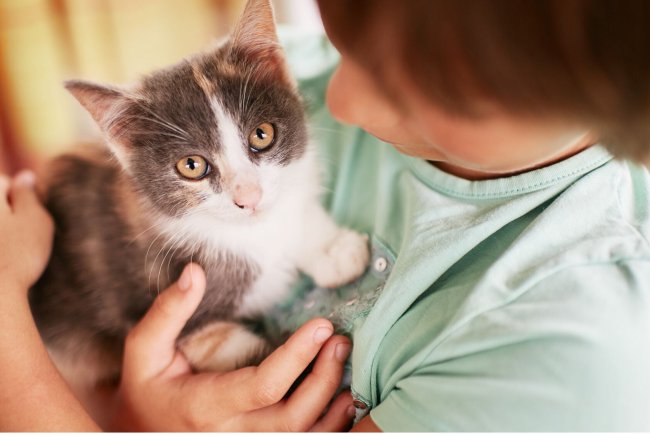Why You Should Get Cat Insurance
Cats are cherished members of our families, offering companionship, comfort, and joy.

Cats are cherished members of our families, offering companionship, comfort, and joy. As a responsible cat owner, ensuring their health and well-being is paramount. One of the best ways to protect your feline friend’s health and manage unexpected expenses is through cat insurance. This article explores the importance of cat insurance, its benefits, common misconceptions, and how to choose the right policy for your pet.
Understanding Cat Insurance
Definition of Cat Insurance
Cat insurance is a policy designed to cover the cost of veterinary care for your cat. It provides financial protection against unexpected medical expenses, allowing you to offer the best care without the stress of significant out-of-pocket costs. Cat insurance typically includes coverage for accidents, illnesses, and sometimes routine care.
Types of Coverage Offered
-
Accident and Illness Coverage: This is the most common type of cat insurance. It covers treatments for injuries and illnesses, including surgeries, hospital stays, and medications. This coverage is essential for managing unexpected health issues.
-
Routine Care and Wellness Coverage: Some policies offer coverage for routine care, such as vaccinations, annual check-ups, dental cleanings, and flea/tick prevention. This can help offset the cost of regular preventive care.
-
Comprehensive Coverage: This combines both accident/illness and routine care coverage, offering a broader range of benefits. It typically includes coverage for specialist consultations, diagnostic tests, and preventive care.
-
Third-Party Liability Coverage: Less common, this type covers damages if your cat causes injury to another person or their property. It’s particularly useful if your cat is known for its adventurous spirit.
How Cat Insurance Works
Cat insurance operates on a similar model to human health insurance. You pay a monthly premium, and in return, the insurance company helps cover the cost of eligible veterinary expenses. Here’s how it typically works:
-
Premiums: The amount you pay monthly or annually for your policy. Premiums vary based on factors such as your cat’s age, breed, and health status.
-
Deductibles: The amount you must pay out-of-pocket before the insurance kicks in. Deductibles can be annual or per-incident, depending on the policy.
-
Reimbursement: After paying the vet bill, you submit a claim to your insurance provider. They reimburse you for covered expenses, minus any deductible and co-payments.
Benefits of Cat Insurance
Financial Protection
One of the primary benefits of cat insurance is financial protection. Veterinary care can be expensive, especially in emergencies or for chronic conditions. For instance, treatments for conditions like diabetes or cancer can cost thousands of dollars. With insurance, you can manage these costs more effectively.
Without insurance, a major medical emergency can strain your finances. Cat insurance helps you avoid making tough decisions based on cost and ensures you can provide the necessary care for your pet. For example, a policy covering $10,000 in medical expenses could significantly reduce the financial burden of an emergency surgery or ongoing treatment for a serious illness.
Access to Better Care
Cat insurance enables you to afford high-quality treatments and specialist care. When financial constraints are minimized, you can focus on getting the best possible care for your cat. Whether it’s a specialized surgery, advanced diagnostic tests, or consultations with veterinary specialists, insurance provides the flexibility to choose the best options for your pet’s health.
For example, if your cat needs a referral to a specialist or advanced imaging like an MRI, insurance can help cover these costs, allowing you to pursue comprehensive treatment options without worrying about the expense.
Preventive and Wellness Care
Routine and preventive care are crucial for maintaining your cat’s health. Some insurance policies cover vaccinations, annual check-ups, dental cleanings, and other preventive services. By having insurance, you’re more likely to keep up with regular veterinary visits, which can prevent more serious and costly health issues in the future.
For instance, regular check-ups can catch potential health problems early, reducing the risk of more severe conditions developing. Vaccinations help protect your cat from various diseases, and dental cleanings can prevent dental issues that may lead to more serious health concerns.
Common Misconceptions about Cat Insurance
Cost Concerns
A common misconception is that cat insurance is too expensive. While premiums can vary based on factors such as your cat’s age, breed, and health history, there are affordable options available. When compared to potential out-of-pocket veterinary costs, insurance often proves to be a cost-effective solution.
For example, a monthly premium for cat insurance might be $30 to $50, while a single emergency visit could cost several hundred dollars. Investing in insurance can save you money in the long run, especially if your cat faces unexpected health issues.
Coverage Limitations
Another misconception is that insurance doesn’t cover much or has numerous exclusions. While it’s true that insurance policies have limitations and exclusions, many providers offer comprehensive coverage for a wide range of conditions. It’s important to understand what is covered and what is not, but many policies offer robust protection for common health issues.
Common exclusions might include pre-existing conditions, certain hereditary conditions, or specific breeds with known health problems. However, many insurers offer policies that cover a broad spectrum of accidents and illnesses, including those not typically covered under standard pet care.
Complexity of Claims
Some pet owners worry about the complexity of filing claims. While the process can seem daunting, most insurance companies have streamlined procedures to make claims submission as straightforward as possible. Many providers offer user-friendly online portals where you can submit claims, track their status, and communicate with customer service representatives.
For instance, you may need to provide invoices and medical records from your veterinarian, but insurance companies often guide you through the process and offer support to ensure your claims are handled efficiently.
Choosing the Right Cat Insurance Policy
Assessing Your Cat’s Needs
When selecting a cat insurance policy, consider your cat’s age, breed, and health history. Younger cats may benefit from policies that include preventive care, while older cats or those with existing health conditions might need more comprehensive coverage. Understanding your cat’s specific needs will help you choose a policy that provides the right level of protection.
For example, if you have a senior cat with a history of health issues, opting for a policy with broader coverage and higher limits might be beneficial. Conversely, if you have a healthy young cat, a more basic policy with accident and illness coverage may suffice.
Comparing Insurance Providers
Not all insurance providers offer the same coverage or pricing. When choosing a policy, compare different providers based on factors such as:
- Coverage Options: Ensure the policy covers the types of care you’re likely to need, such as emergency care, surgeries, and preventive services.
- Premiums and Deductibles: Compare costs to find a policy that fits your budget while offering adequate coverage.
- Customer Reviews: Research customer reviews and ratings to gauge the quality of service and claims handling.
- Provider Reputation: Choose a reputable provider known for reliable coverage and good customer service.
Reading the Fine Print
Before purchasing a policy, thoroughly review the terms and conditions. Pay attention to details such as exclusions, waiting periods, and limits on coverage. Understanding these aspects will help you avoid surprises and ensure the policy meets your needs.
For instance, some policies might have waiting periods for certain types of coverage, or limits on how much can be claimed for specific conditions. Knowing these details will help you make an informed decision and choose a policy that provides the coverage you expect.
Consulting with Your Vet
Your veterinarian can provide valuable insights into your cat’s health needs and recommend suitable insurance options. They may have experience with different insurance providers and can offer advice on which policies align with your cat’s health profile.
For example, your vet might suggest a policy that includes coverage for specific treatments or conditions that are common for your cat’s breed or age. They can also help you understand the types of care that might be necessary in the future, allowing you to choose a policy that addresses those needs.
Real-Life Examples
Case Studies
-
Emergency Surgery: A cat named Whiskers required emergency abdominal surgery after ingesting a foreign object. The cost of the surgery and follow-up care was over $3,000. With insurance coverage, the owner only had to pay a fraction of the total cost, significantly easing the financial burden.
-
Chronic Condition Management: Another cat, Bella, was diagnosed with diabetes. Ongoing treatment, including insulin injections and regular vet visits, added up to over $1,500 annually. With insurance coverage for chronic conditions, Bella’s owner was able to manage these costs effectively and ensure Bella received the necessary care.
Personal Stories
Many cat owners have shared positive experiences with insurance. For example, one pet owner recounted how insurance allowed them to pursue specialist treatments for their cat’s rare condition, which would have otherwise been financially prohibitive. Another owner appreciated having insurance coverage for routine care, which helped maintain their cat’s health without unexpected costs.
Final Thoughts
Cat insurance is a valuable investment for any cat owner, providing financial protection, access to better care, and encouragement for preventive health measures. By understanding the benefits of insurance, addressing common misconceptions, and carefully choosing the right policy, you can ensure that your feline friend receives the best possible care throughout their life. Protecting your cat’s health with insurance is a responsible and proactive step in responsible pet ownership, offering peace of mind and financial security in times of need.
FAQ:
1. What is cat insurance?
Cat insurance is a policy that helps cover the cost of veterinary care for your cat. It can include coverage for accidents, illnesses, and sometimes routine care, depending on the policy.
2. What types of coverage are available with cat insurance?
Cat insurance typically offers several types of coverage:
- Accident and Illness Coverage: For emergency treatments and illnesses.
- Routine Care and Wellness Coverage: For preventive care like vaccinations and annual check-ups.
- Comprehensive Coverage: A combination of accident/illness and routine care coverage.
- Third-Party Liability Coverage: Covers damages if your cat causes injury or property damage.
3. How does cat insurance work?
You pay a monthly or annual premium, and in return, the insurance company helps cover eligible veterinary expenses. You also have a deductible to meet before the insurance starts reimbursing you. After paying the vet bill, you file a claim, and the insurer reimburses you for covered costs minus any deductible and co-payments.
4. What are the main benefits of having cat insurance?
The key benefits include:
- Financial Protection: Helps manage unexpected veterinary expenses.
- Access to Better Care: Enables you to afford high-quality treatments and specialists.
- Preventive and Wellness Care: Encourages regular vet visits and covers routine care costs.
5. Is cat insurance expensive?
While premiums can vary, cat insurance is often more affordable than the potential out-of-pocket costs of veterinary care. For many pet owners, the cost of insurance is a small price to pay compared to the financial impact of unexpected medical expenses.
6. What are some common misconceptions about cat insurance?
- Cost Concerns: Insurance may be more affordable than expected, especially when compared to potential vet bills.
- Coverage Limitations: Policies often cover a broad range of conditions, though some exclusions may apply.
- Complexity of Claims: Many insurers have streamlined claim processes to make it easier for you to get reimbursed.
7. How do I choose the right cat insurance policy?
Consider your cat’s age, breed, and health needs when selecting a policy. Compare providers based on coverage options, premiums, customer reviews, and provider reputation. Be sure to read the policy details carefully to understand what is covered and any exclusions.
8. What should I look for in a cat insurance policy?
Look for policies with comprehensive coverage, reasonable premiums and deductibles, good customer reviews, and clear terms. Ensure the policy meets your cat’s specific health needs and provides adequate protection for potential health issues.
9. Can I get cat insurance for preventive care?
Yes, some insurance policies cover routine and preventive care, such as vaccinations, annual check-ups, and dental cleanings. This can help offset the cost of maintaining your cat’s health and prevent future issues.
10. How do I file a claim with my cat insurance provider?
Typically, you submit a claim by providing invoices and medical records from your veterinarian. Many insurance companies offer online portals for easy claims submission and tracking. Contact your insurance provider for specific instructions on filing claims.
11. Are there any real-life examples of how cat insurance helps?
Yes, there are numerous stories of cat owners benefiting from insurance, such as covering the costs of emergency surgeries or managing chronic conditions like diabetes. Insurance can alleviate financial stress and ensure your cat receives the necessary care.
12. Is it worth getting cat insurance if my cat is healthy?
Yes, even healthy cats can face unexpected health issues or accidents. Cat insurance provides peace of mind and financial protection for any unforeseen circumstances, making it a wise investment for responsible pet ownership.
What's Your Reaction?



















